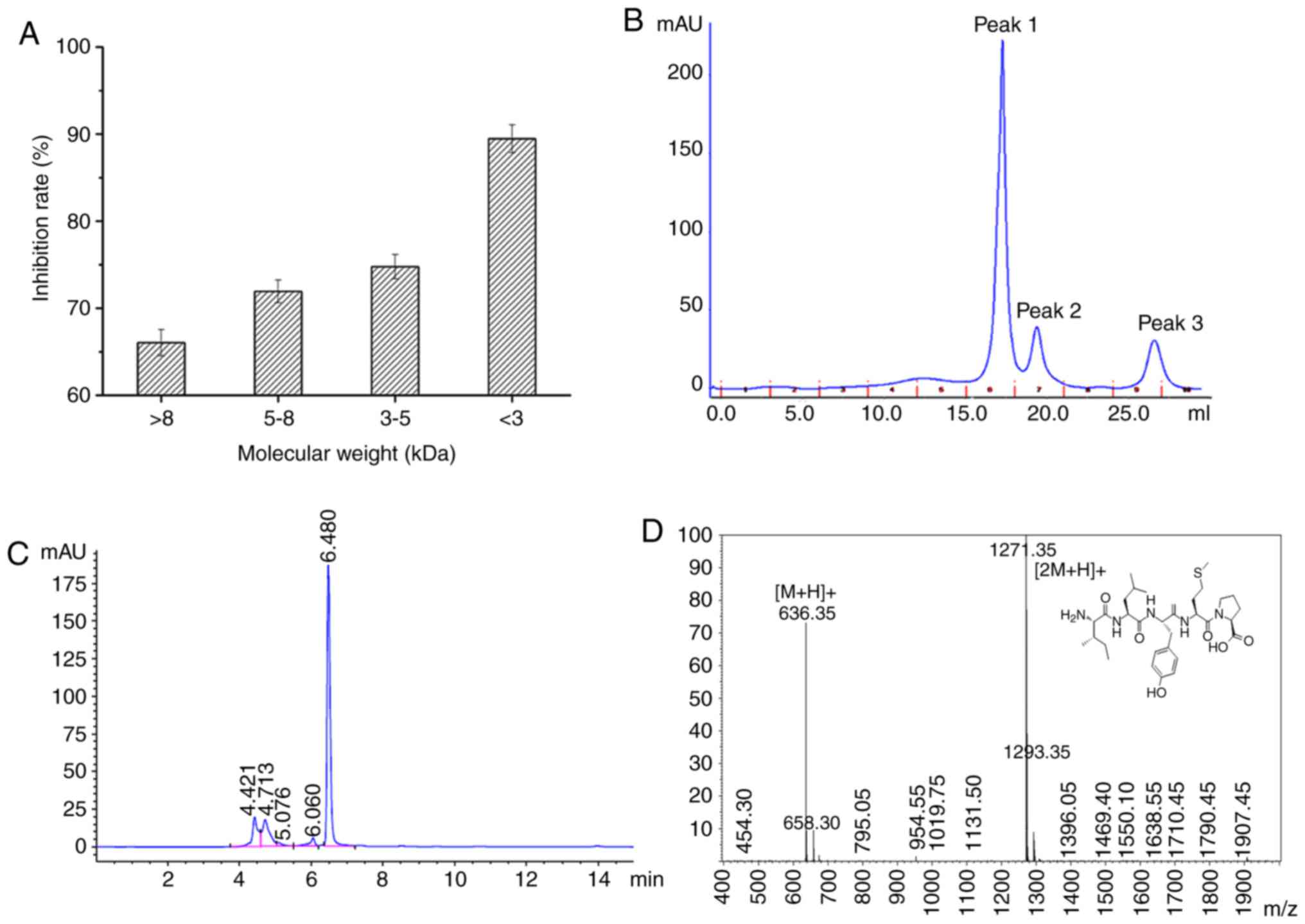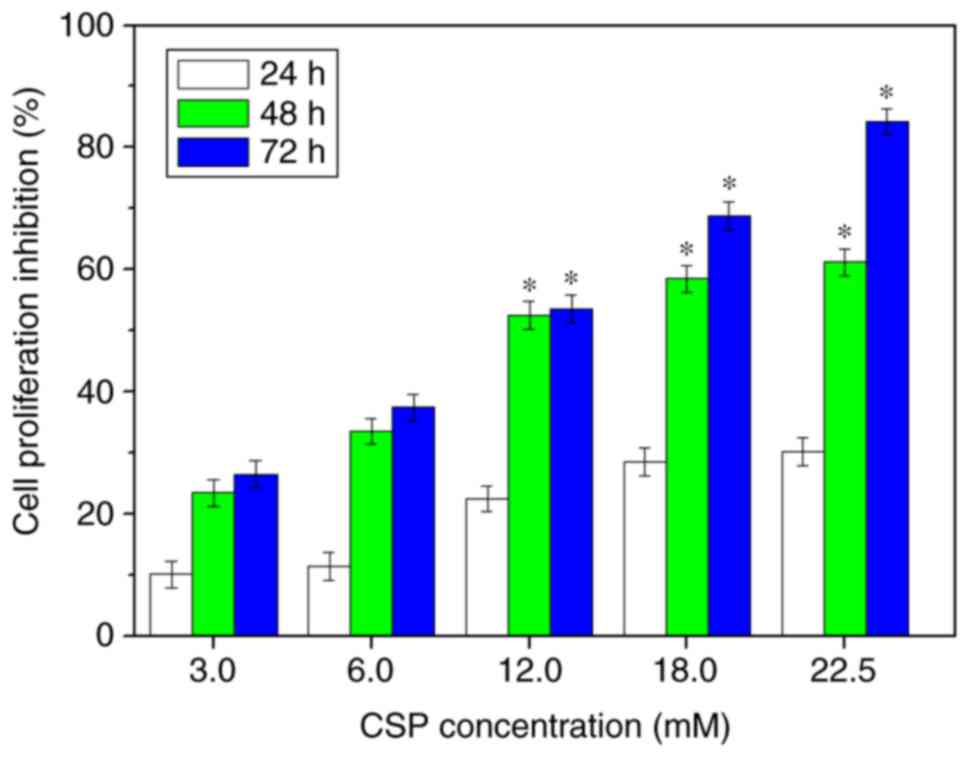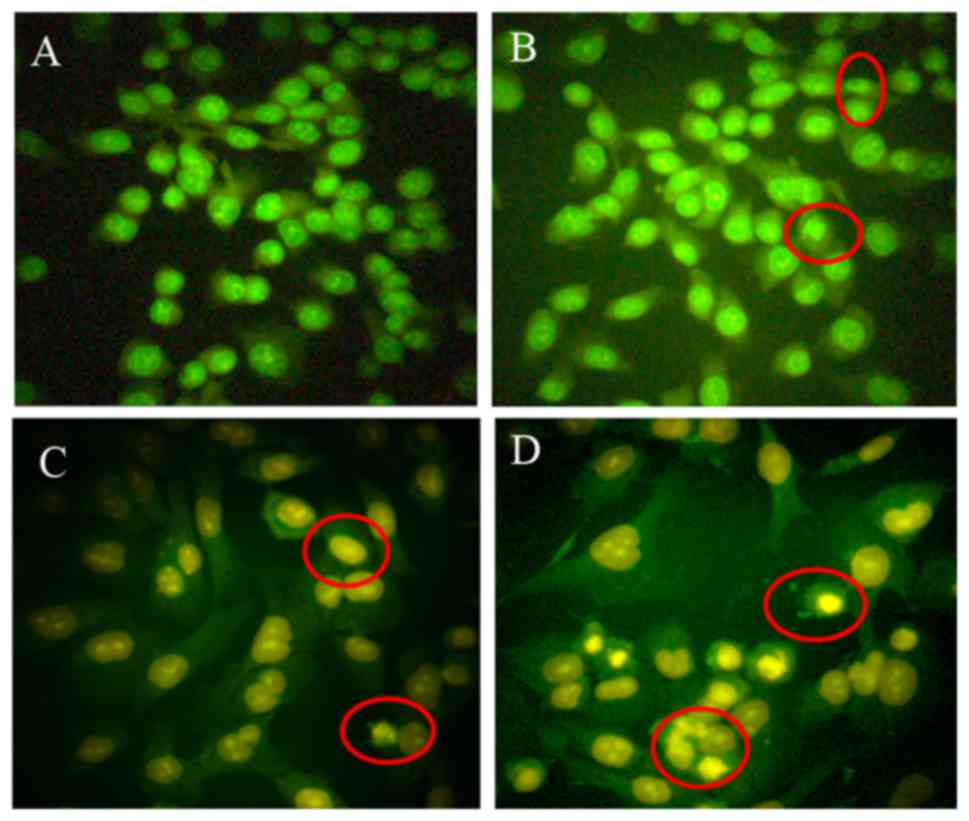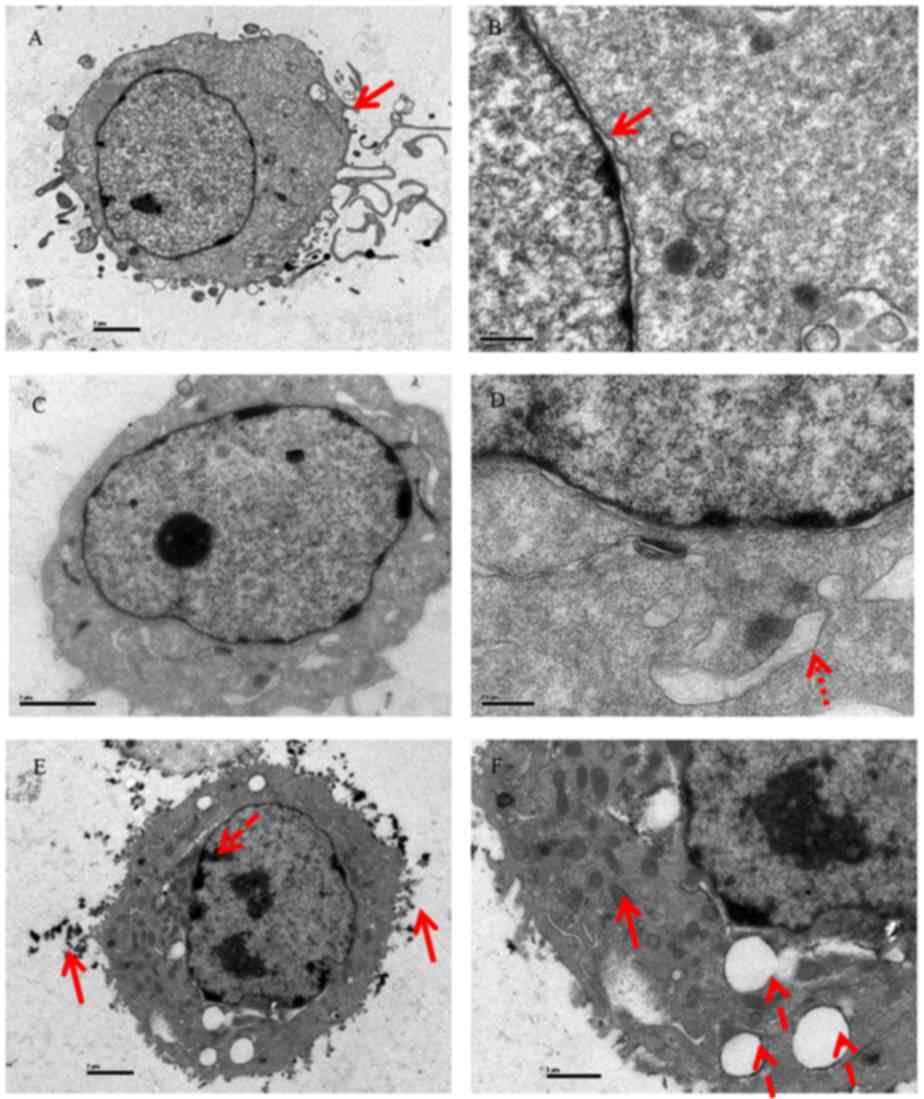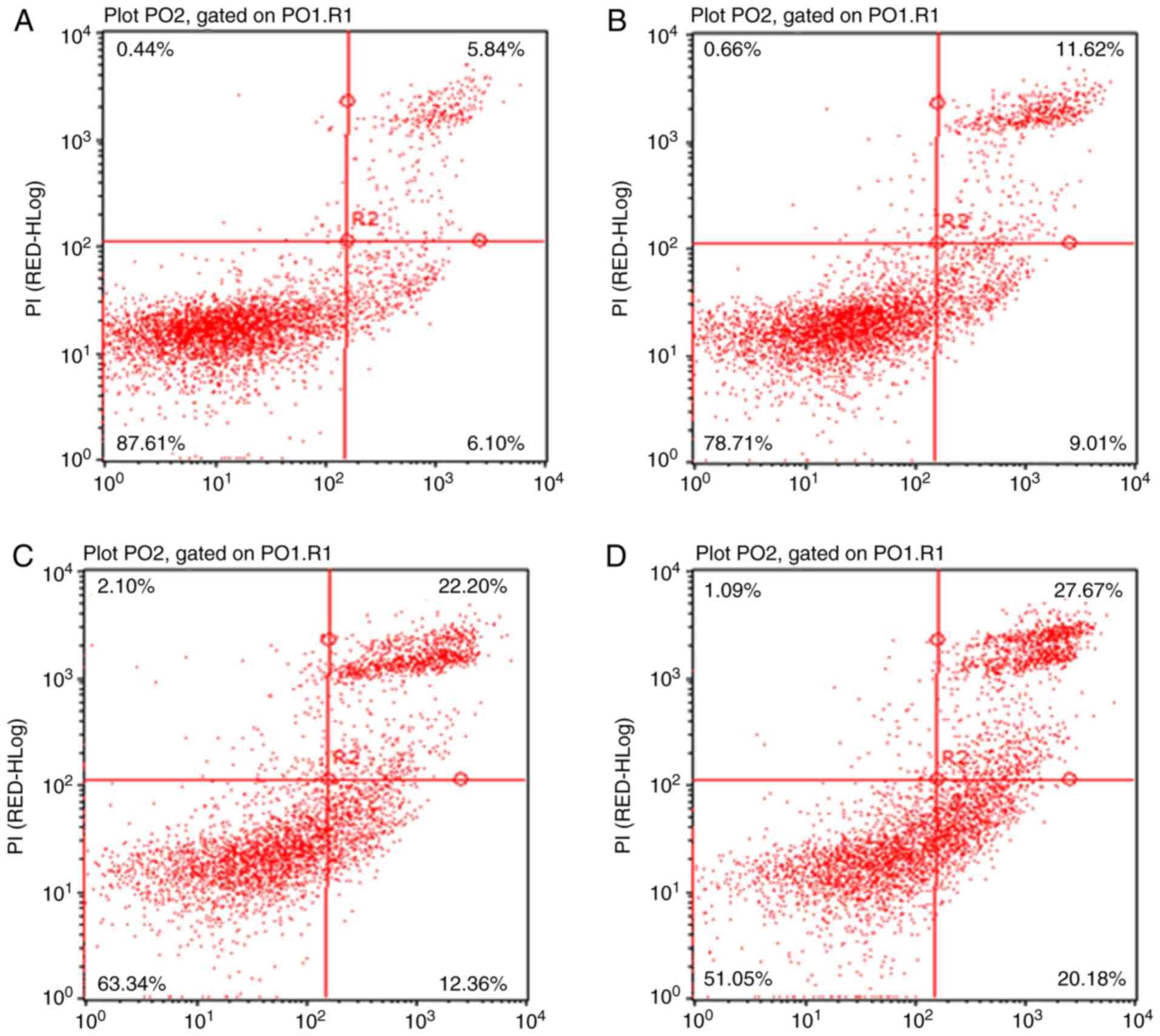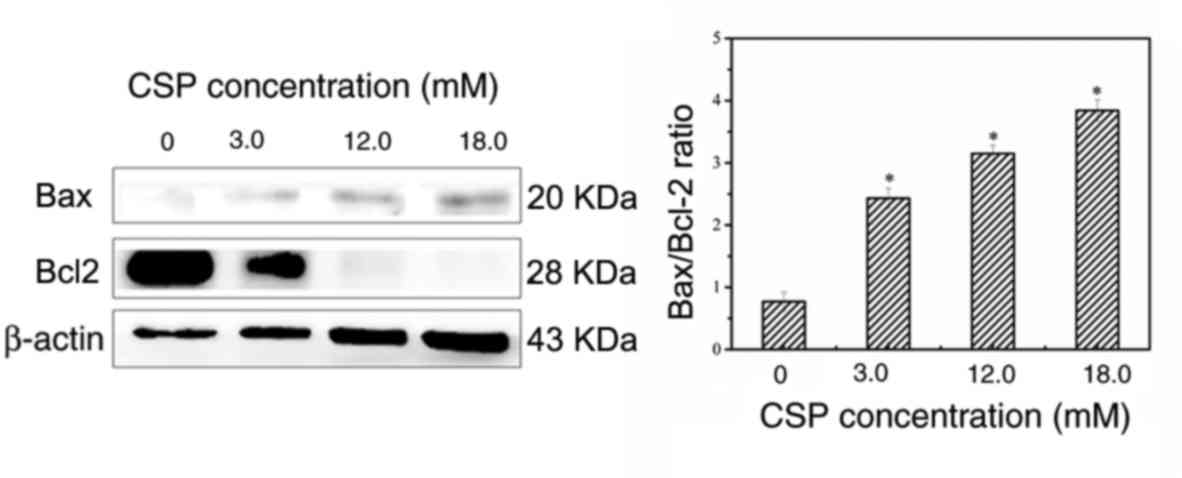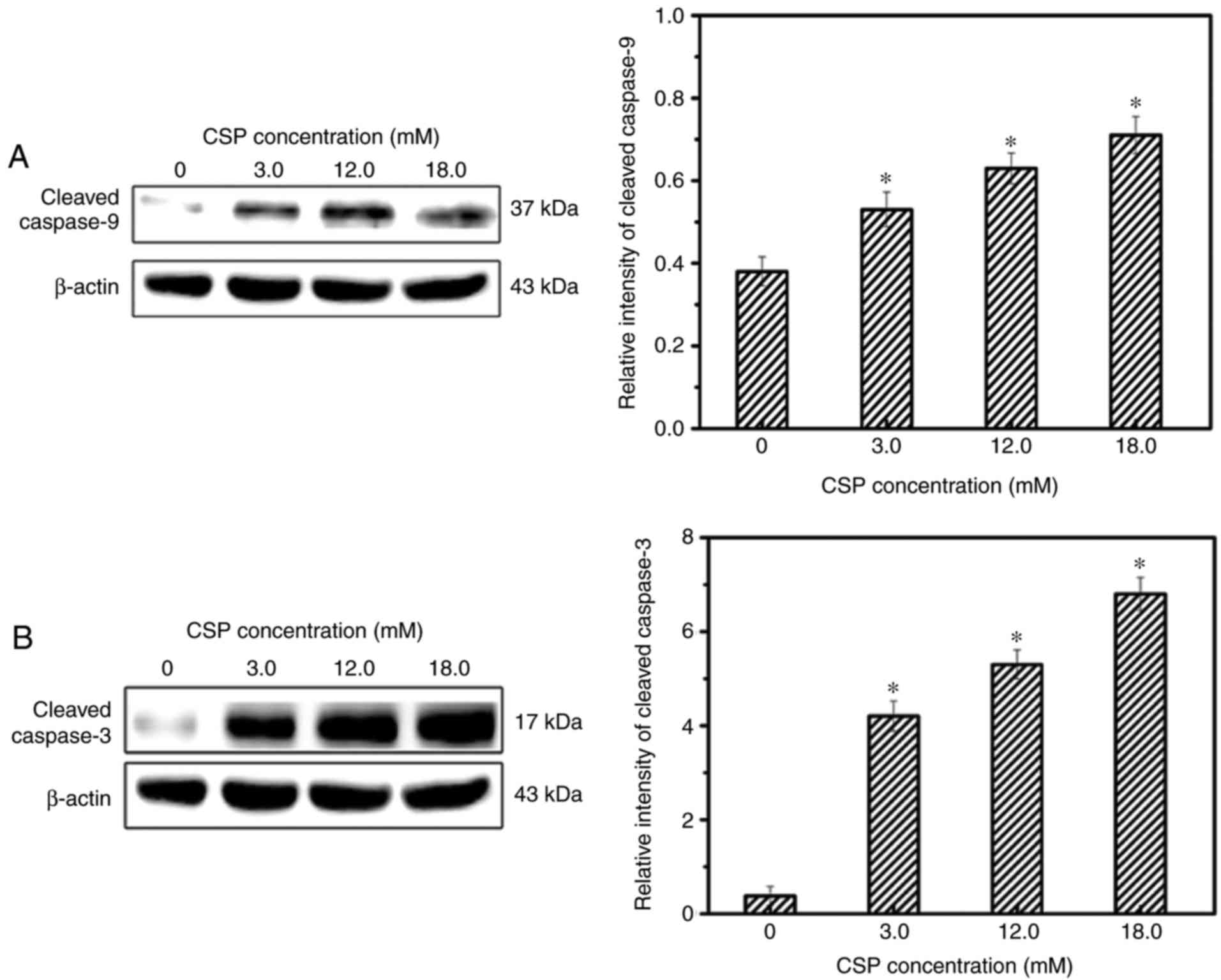A novel anti‑proliferative pentapeptide (ILYMP) isolated from Cyclina sinensis protein hydrolysate induces apoptosis of DU‑145 prostate cancer cells
- Authors:
- Published online on: May 14, 2018 https://doi.org/10.3892/mmr.2018.9019
- Pages: 771-778
-
Copyright: © Yu et al. This is an open access article distributed under the terms of Creative Commons Attribution License.
Abstract
Introduction
Prostate cancer (PCa) is one of the most prevalent malignancies in men in the USA and worldwide, and is the second leading cause of cancer associated mortality in men (1,2). Each year, more than 913,000 novel cases are diagnosed worldwide, resulting in the mortalities of >261,000 patients (3). In addition, the incidence and mortality rate of PCa in China continues to rapidly increase, particularly in patients suffering from obesity or diabetes (4,5). Androgen deprivation therapy has been previously demonstrated to be effective in ~90% of patients with PCa. However, androgen deprivation therapy may develop into androgen-independent PCa and eventually into lethal, castration-resistant PCa (6). Researchers have developed second generations of hormone therapy, such as abiraterone and enzalutamide for the treatment of PCa (7,8). Despite such therapies improving overall survival, the majority of patients with PCa develop resistance following initial treatment, and so further investigation is required to develop novel therapeutic treatment strategies with a low toxicity.
Biofunctional peptides (2–20 amino acids) are protein fragments that may exhibit numerous physiological effects, such as anticancer (9,10), anti-thrombosis (11), antioxidant (12,13), anti-fatigue (14,15) and antimicrobial (16,17). Recently, numerous antitumor peptides have been isolated from marine derived protein hydrolysates to induce PCa cell apoptosis (18–20). Huang et al (18) demonstrated that a tripeptide (Gln-Pro-Lys; QPK) isolated from sepia ink inhibits the proliferation of numerous human PCa lines (DU-145, PC-3 and LNCaP); whereas Song et al (19) revealed that a hexapeptide (Tyr-Ala-Leu-Arg-Ala-His; YALRAH), obtained from the heated products of protein hydrolysates isolated from Setipinna taty, inhibits PC-3 cell proliferation. Furthermore, Kim et al (20) demonstrated that a decapeptide (Ala-Val-Leu-Val-Asp-Lys-Gln-Cys-Pro-Asp; AVLVDKQCPD), isolated from the protein hydrolysates of Ruditapes philippinarum, inhibits the proliferation of PCa cells. Notably, numerous biofunctional peptides have been purified from fish sources, whereas only a number of studies have investigated proteins obtained from crustacean and mollusk sources. Cyclina sinensis, a bivalve mollusk belonging to the Veneridae family, has been used in traditional Chinese medicine for the treatment of inflammation, asthma and dental ulcers (21,22). Furthermore, it has been revealed that Cyclina sinensis has a high quantity of protein, polysaccharides and lipids, which may attribute to its therapeutic effects, such as anticancer, antioxidant and hepatoprotective activities (21–23).
Jiang et al (22,23) reported that the polysaccharide fraction of Cyclina sinensis (CSPS) exhibits significant inhibitory effects against human gastric cancer BGC-823 cells in vivo. In our previous study (24), the anti-proliferative potential of protein hydrolysates isolated from Cyclina sinensis was determined; however, the active component in the protein hydrolysates was not investigated further. Therefore, the present study aimed to isolate the pentapeptide (Ile-Leu-Tyr-Met-Pro; ILYMP) of interest from Cyclina sinensis protein hydrolyastes via ultrafiltration as well as chromatographic methods, and was subsequently named CSP. The effect of CSP on the PCa cell line DU-145 was investigated using methylthiazolyldiphenyl-tetrazolium bromide (MTT) assays, acridine orange/ethidium bromide double staining (AO/EB), scanning electron microscopy and flow cytometry. Furthermore, western blotting was performed, and the results demonstrated that the Bcl-2-associated X (Bax), cleaved caspase-3 and cleaved caspase-9 proteins were activated in CSP-treated DU-145 cells; whereas B-cell lymphoma-2 (Bcl-2) was suppressed in CSP-treated DU-145 cells. These results suggest that CSP can inhibit the proliferation of human PCa cells and may represent a therapeutic nutraceutical agent for the treatment and prevention of PCa.
Materials and methods
Materials
Cyclina sinensis were purchased from a local fish market in Zhoushan, China. Trypsin and neutral protease were purchased from YTHX Biotechnology Co., Ltd. (Beijing, China). MTT and Annexin V-FITC apoptosis detection kits were purchased from Sigma-Aldrich; Merck KGaA (Darmstadt, Germany). The DU-145 PCa cell lines and NIH-3T3 cell lines were purchased from the Shanghai Institute of Biochemistry and Cell Biology (Shanghai, China). Antibodies against β-actin (cat. no. AA132), Bax (cat. no. AB026), Bcl-2 (cat. no. AB112), caspase-3 (cat. no. AC030) and caspase-9 (cat. no. AC062) were purchased from Beyotime Institute of Biotechnology (Shanghai, China). Horseradish peroxidase-conjugated goat-anti-rabbit secondary antibodies (cat. no. A0208) were purchased from Beyotime Institute of Biotechnology. All other reagents used were of analytical grade.
Fractionation of protein hydrolysates by ultrafiltration
Cyclina sinensis were hydrolyzed using neutral protease under conditions: 1,200 U/g, solid-liquid ratio 1:4, (pH 7.0) at 45°C for 6 h. The protein hydrolysates were then fractionated using ultrafiltration (Amicon 8400; EMD Millipore, Billerica, MA, USA) with 3, 5 and 8 kDa molecular weight cut-off membranes at 0.30 MPa, 20°C. The fractions were then collected as follows: >8, 8–5, 5-3, and <3 kDa. Fractions were then lyophilized at −60°C to further investigate whether Cyclina sinensis exhibits an antitumor effect on DU-145 cells.
Gel filtration chromatography
The elution with the highest antitumor activity following ultrafiltration was dissolved in 0.1 M Tris-HCl (0.05 g/ml, pH 7.0), 500 µl sample was added to a Superose 12 10/300 GL (GE Healthcare, Chicago, IL, USA; 10×300 mm) pre-equilibrated with Tris-HCl (0.1 M, pH 7.0) and then eluted at a flow rate of 1 ml/min using an AKTA purifier 100 (GE Healthcare) at room temperature. Fractions were isolated and detected at 280 nm, and the elution peaks were then isolated and lyophilized at −60°C to investigate antitumor activity analysis.
High performance liquid chromatography (HPLC)
The elution with the highest antitumor activity was further separated using reverse phase (RP)-HPLC (Agilent 1260; Agilent Technologies, Inc., Santa Clara, CA, USA) on a Agilent Zorbax SB-C18 (4.6×250 mm; 5 µm) column with a linear gradient of acetonitrile (0–7%) containing 0.06% trifluoroacetic acid at a flow rate of 1.0 ml/min. The purification was repeated >20 times at the same elution conditions and the final purified peptide (CSP) was collected and subsequently lyophilized at −60°C to determine its amino acid sequence as well as its antitumor activity against DU-145 cells.
Determination of amino acid sequence and molecular mass of CSP
CSP was dissolved in 15 µl 37% CH3CN (v/v) solution and applied to TFA-treated glass fiber filters (Shimadzu Corporation, Kyoto, Japan) and then sequenced at the N-terminus using a PPSQ-31A protein sequencer (Shimadzu Corporation). A mass spectrometer (Waters ZQ 2000; Waters GmbH, Eschborn, Germany) combined with an electrospray ionization source was used to determine the molecular weight of the final purified peptide. Ionization was carried out in positive ion mode with a capillary voltage of 3.5 kV, a nebulizer gas (N2) temperature of 250°C and flow rate of 1.5 l/min.
Anti-proliferative activity against DU-145 cells
The effects of CSP on cell proliferation were determined using the MTT colorimetric assay according to the protocol detailed by Tang et al (25), with a number of modifications. Briefly, DU-145 cells were seeded in a 96-well plate (1×104 cells/well) and incubated at 37°C overnight. Cells were then treated with different concentrations of CSP (0, 3.0, 6.0, 12.0, 18.0 and 22.5 mM) for 24, 48 and 72 h time intervals at 37°C. Following this, PBS (200 µl) with 10% MTT was added to each well at room temperature. The medium was then removed, DMSO (150 µl) was added and the plates were then incubated at 37°C for a further 4 h. The plates was transferred into a TYZD-I oscillator (Beijing BILON Co., Ltd., Beijing, China) and incubated for 15 min at room temperature. The cell proliferation inhibition rate (%) was calculated using the following equation: Inhibition percentage (%)=[(ODcontrol-ODtreated)/(ODcontrol-ODblank)] ×100%
Acridine orange/ethidium bromide (AO/EB) staining
Cell morphology was investigated using AO/EB double staining as described by Tang et al (25). To accurately distinguish cells in different stages of apoptosis, DU-145 cells in exponential phase were digested using 0.25% trypsin, suspended at a final concentration of 1×105 cells/well in a 6-well flat-bottomed plate and then cultured at 37°C in a 5% CO2 incubator. Cells were then treated with 0, 3.0, 12.0 and 18.0 mM CSP for a further 24 h. Finally, cells were stained using the AO/EB dye mixture (100 µg/ml) and the morphology of apoptotic cells was then immediately investigated using a fluorescent microscope (Leica DM 3000; Leica Microsystems GmbH, Wetzlar, Germany).
Scanning electron microscope
DU-145 cells were seeded in a 25 ml culture vessel and treated with 0, 3.0 and 12.0 mM CSP at 37°C. When cells reached a final concentration of 1×105 cells/ml, they were subsequently cultured at 37°C in a 5% CO2 incubator for 24 h. The harvested cells were fixed with 2.5% glutaraldehyde for 24 h and 1.5% osmium acid for 2 h at room temperature, dried and coated with gold by an ion sputtering coating machine. Finally, the cells were observed using a scanning electron microscope (Hitachi H-7650; Hitachi, Ltd., Tokyo, Japan).
Cell apoptosis analysis
Cell apoptosis rates were determined using an Annexin V fluorescein isothiocyanate (FITC)/propidium iodide (PI) staining assay and flow cytometry (BD Biosciences, Franklin Lakes, NJ, USA). Briefly, DU-145 cells were cultured in 6-well flat-bottomed plates at 37°C for 24 h and then treated with 0, 3.0, 12.0 and 18.0 mM CSP for a further 24 h. Harvested cells were then digested with 0.25% trypsin, resuspended in phosphate buffer and then collected by centrifugation (1,000 × g, 4°C for 5 min). Finally, the cells were incubated with 5 µl of Annexin V-FITC and 10 µl of PI for 15 min at room temperature in the dark and then immediately analyzed by flow cytometry using a flow cytometer.
Western blot analysis
Total protein lysates from the different cell groups were extracted using RIPA lysis buffer (Beyotime Institute of Biotechnology, Shanghai, China), quantified by using BCA protein assay kit and equal amounts of protein (50 µg) were loaded per well on a 10% SDS-PAGE gel and then separated. Following SDS-PAGE, proteins were transferred to a polyvinylidene difluoride membrane and the membrane was then blocked using 10% non-fat milk for 1.5 h at room temperature. The membrane was incubated with specific primary antibodies (β-actin, Bax, Bcl-2, caspase-3 and caspase-9; 1:1,000) at 4°C overnight and then washed three times using Tris-HCl with 0.05% Tween-20. Following this, the membrane was incubated with horseradish peroxidase-conjugated goat-anti-rabbit secondary antibodies (1:3,000) at room temperature for 2 h. The intensity of specific bands was visualized using enhanced chemiluminescence (FluorChem FC3, Protein Simple, Inc., San Jose, CA, USA) and then quantified using Quantity One software (version 4.62; Bio-Rad Laboratories, Inc., Hercules, CA, USA).
Statistical analysis
Data are presented as the mean ± standard deviation of at least four independent experiments. Data were analyzed by one-way analysis of variance with Turkey's test using the SPSS 19.0 software (IBM Corps., Armonk, NY, USA). P<0.05 was considered to indicate a significant difference.
Results and Discussion
Purification of activity peptide and peptide identification
The target peptide was purified from Cyclina sinensis protein hydrolysates via ultrafiltration, gel filtration chromatography and RP-HPLC. The anti-proliferative activity of the peptide against DU-145 cells was used to monitor the purification process. The <3 kDa peptide fraction was revealed to demonstrate the greatest anti-proliferative activity towards DU-145 cells (89.46±4.47%; Fig. 1A). Chi et al (9) reported that <1 kDa peptide fractions isolated from blood clam protein hydrolysates exhibit the greatest anti-proliferative activity against PC-3, DU-145 and H1299 cells. Similar results were observed in protein hydrolysates obtained from Setipinna taty and Ruditapes philippinarum (26,27). The results of the present study were consistent with previous findings suggesting that short peptides exhibited greater anticancerous activities, and thus <3 kDa peptide fractions were subsequently collected and lyophilized for further investigation.
Following this, fractions <3 kDa were separated into three sub-fractions (peak 1, peak 2 and peak 3). The results of the MTT assay revealed that peak 3 exhibited the greatest anti-proliferative activity (12 mM; 59.46±3.67% CSP treatment for 24 h) towards DU-145 cells compared with peak 1 and peak 2 (Fig. 1B). Subsequently, peak 3 was collected, lyophilized and further purified via preparative RP-HPLC. The peak with a retention time of 6.480 min demonstrated the greatest inhibitory effect on DU-145 cell proliferation (Fig. 1C). Following this, this peak was further purified ~20 times via preparative RP-HPLC and subsequently subjected to MS and amino acid sequence analysis. Following analysis using a Shimadzu PPSQ-31A protein sequencer and electrospray ionization-mass spectrometry, the amino acid sequence of CSP was determined to be ILYMP (Fig. 1C) with a molecular weight of 635.35 Da [(M+H)+; Fig 1D], which was consistent with a theoretical mass of CSP (635.71 Da).
CSP exhibits an anti-proliferative effect against DU-145 cells
Cell proliferation occurs in almost all tissues and regulates cell proliferation and programmed cell death in order to ensure tissue and organ integrity. However, uncontrolled cell division may result in tissue hyperplasia as well as the development of diseases, such as cancer (10,28). Thus, inhibition of cell proliferation is considered to represent an effective therapeutic strategy for the treatment of cancer. In the present study, MTT assays were used to determine the inhibitory effect of CSP on DU-145 cell proliferation. The results revealed that CSP exhibited a marked increase in cytotoxicity against DU-145 cells in a dose-dependent manner, with an inhibition rate of ~84.17% at 22.5 mM at the 72 h time interval (Fig. 2). The half-maximal inhibitory concentration (IC50) of CSP was ~11.25 mM at the 72 h time interval. Furthermore, CSP did not exhibit any toxicity towards the normal NIH-3T3 cells (data not shown), which are frequently used as a healthy control cell line (8). Therefore, the results suggested that CSP exhibited selective toxicity towards cancer cells compared with normal cells.
Morphological observations
AO/EB staining has been previously used to investigate apoptosis in cancer cells (25,29). The present study aimed to determine whether CSP-induced inhibition of cell proliferation occurs via apoptosis by treating DU-145 cells with 3.0, 12.0 and 18.0 mM CSP and observing changes in cell morphology using AO/EB staining (Fig. 3). Early-stage apoptotic cells, marked by crescent-shaped or granular yellow green AO nuclear staining, were observed following treatment with 3.0 and 12.0 mM CSP for 24 h, which suggested that DU-145 cells were undergoing early stage apoptosis (Fig. 3A, B and C). Late-stage apoptotic cells, with concentrated and asymmetrically localized nuclear AO/EB staining, were observed following treatment with 18.0 mM CSP for 24 h (Fig. 3D). The morphological characteristics of apoptotic DU-145 cells in the present study were similar to the results of AO/EB staining in previous studies using DU-145, PC-3 and LNCaP cells that were treated with sepia ink oligopeptide QPK (18), HeLa cells treated with a hexapeptide (Phe-Ile-Met-Gly-Pro-Tyr; FIMGPY) isolated from Raja porosa cartilage protein hydrolysates (10) and PC-3 cells treated with a peptide (Arg-Asp-Gly-Asp-Ser-Cys-Arg-Gly-Gly-Gly-Pro-Val; RDGDSCRGGGPV) isolated from Bullacta exarata (30).
Scanning electron microscopy was used to further investigate the effects of CSP on DU-145 cells. Cells in the control group did not exhibit any typical morphological changes (microvilli reduction or disappearance, chromatin condensation or margination) (Fig. 4A and B). However, typical morphological changes were observed when cells were treated with 3.0 (Fig. 4C and D) and 12.0 mM CSP for 24 h (Fig. 4E and F), such as a loss of microvilli structures on the surface of the cell membrane, chromatin condensation and the presence of apoptosis bodies. Furthermore, an expansion of the smooth endoplasmic reticulum, loss of mitochondrial cristae and an appearance of numerous cytoplasmic vacuoles were observed in CSP-treated DU-145 cells. In conclusion, these results suggested that apoptosis is enhanced in cells following treatment with CSP, and the morphological features observed were similar to those observed in DU-145 cells following treatment with an oligopeptide (Asp-Trp-Pro, DWP) isolated from Ruditapes philippinarum (31).
Cell apoptotic rate is enhanced in DU-145 cells following treatment with CSP
Cancer is a disease state characterized by disordered cell proliferation and inhibition of apoptosis. Previous therapeutic strategies for the treatment of tumors have focused on the inhibition of cell proliferation and the induction of apoptosis. In order to further investigate the induction of apoptosis by CSP, flow cytometric analysis was performed and the rate of cellular apoptosis was determined using Annexin V-FITC/PI double staining. The results revealed that the percentage of Annexin V-FITC stained DU-145 cells in the control group was 6.10±1.1% (Fig. 5A). Following 24 h exposure to 3.0, 12.0, and 18.0 mM CSP, the percentage of apoptotic cells increased to 9.01±1.3% (Fig. 5B), 12.36±1.8% (Fig. 5C) and 20.18±1.9% (Fig. 5D), respectively; thus demonstrating a marked increase in apoptosis rates following treatment with CSP in a dose-dependent manner. Therefore, the results suggested that CSP induced apoptosis in DU-145 cells.
Expression levels of apoptosis associated proteins in DU-145 cells are increased following treatment with CSP
The results of the flow cytometry analysis suggested that apoptosis was increased in DU-145 cells following treatment with CSP in a dose-dependent manner. In order to investigate the underlying mechanisms, expression levels of anti- and pro-apoptosis associated proteins were determined in CSP-treated DU-145 cells via western blotting. The Bcl-2 protein family plays an important role in the regulation of apoptosis, and includes pro-apoptotic proteins (Bax, Bcl-2 associated agonist of cell death and Bcl-X) as well as anti-apoptotic proteins (Bcl-2, Bcl-extra large and Bcl-2-like protein) (32). Thus, the ratio between Bax and Bcl-2 protein expression is frequently used as an apoptotic index (10,18,25). The western blotting results demonstrated that Bcl-2 expression was significantly decreased, whereas the expression of Bax was significantly increased following treatment with CSP in a dose-dependent manner, thus resulting in a dose-dependent increase in the Bax/Bcl-2 ratio in CSP-treated DU-145 cells (Fig. 6). These results therefore suggested that treatment with CSP significantly enhanced apoptosis via upregulation of the Bax/Bcl-2 ratio in DU-145 cells.
In addition, caspase proteins are important for the maintenance of cellular homeostasis via the regulation of cell death and inflammation, and may be classified as initiator caspases (caspase-8/9) or executioner caspases (caspase-3/6/7) (33). Caspase-9 protein is an important component of the mitochondrial death pathway and caspase-3 is the predominant downstream effector caspase responsible for cleaving the majority of the cellular substrates in apoptotic cells (34). Western blotting analysis revealed that the protein expression of cleavedcaspase-3 and cleavedcaspase-9 were significantly increased following treatment with CSP in a dose-dependent manner (Fig. 7). Therefore, the results suggest that CSP-induced apoptosis is associated with the mitochondrial-mediated death pathway in DU-145 cells.
CSP exhibits anticancer activity
It has been previously established that the hydrophobic properties of amino acids affect their anticancer activities. For example, the A and L residues in the YALPAH peptide isolated from Setipinna taty peptide hydrolysates were revealed to be associated with its anti-proliferative activities against PC-3 cells (26). F, I, M, P and Y residues in the sequence of the FIMGPY hexapeptide isolated from Raja porosa cartilage were also demonstrated to be associated with its anticancer activities against HeLa cells (10). Therefore, it can be suggested that the amino acid residues in the CSP sequence (ILYMP) may contribute to its anticancer activities. The CSP isolated from Cyclina sinensis exhibited anticancer activity to DU-145 cells, with lower toxicity to normal cells. The properties of this pentapeptide make it a promising therapeutic agent for PCa prevention or treatment. Further investigation in future studies is required to fully characterize CSP activity both in vitro and in vivo.
In conclusion, an anti-proliferation pentapeptide (ILYMP) named CSP was obtained from protein hydrolysates isolated from Cyclina sinensis via ultrafiltration and chromatographic methods. The results revealed that CSP inhibited the proliferation of DU-145 cells with an IC50 of 11.25 mM at 72 h. Furthermore, AO/EB staining, scanning electron microscopy and flow cytometry analyses demonstrated that CSP suppresses DU-145 cell proliferation via the induction of apoptosis. Enhanced expression of Bax and cleaved caspase-3/9 as well as suppression of Bcl-2 expression was observed in CSP-treated DU-145 cells. To the best of the authors' knowledge, this is the first study to investigate the effects of an antiproliferative peptide on DU-145 cells derived from Cyclina sinensis, and the results revealed that the Cyclina sinensis extract may have a therapeutic effect on PCa. However, the underlying mechanism of CSP-induced apoptosis was not fully determined, and our future studies will focus on revealing the molecular and proteomic mechanisms associated with this effect, using in vitro and in vivo studies.
Acknowledgements
The authors would like to thank Dr. Xiaojun Zhang from Aquatic Processing Department, Zhejiang Marine Fisheries Research Institution for measuring the molecular weight of the CSP.
Funding
This research was supported by the Natural Science Foundation of Zhejiang Province (grant nos. LQ16H300001, LY12C20005 and LY12C20008), the Foundation of Zhejiang Educational Committee (grant no. Y201534400) and the Public Welfare Program of Zhoushan (grant no. 2015C31012).
Availability of data and materials
The data used in the current study are available from the corresponding author on reasonable request.
Authors' contributions
ZY and FY conceived and designed the experiments. YZ, LY and YT performed the experiments. GD and XZ conducted data analysis. All authors read and approved the manuscript.
Ethics approval and consent to participate
Not applicable.
Consent for publication
Not applicable.
Competing interests
The authors declare that they have no competing interests.
References
|
Torre LA, Bray F, Siegel RL, Ferlay J, Lortet-Tieulent J and Jemal A: Global cancer statistics, 2012. CA Cancer J Clin. 65:87–108. 2015. View Article : Google Scholar : PubMed/NCBI | |
|
Choo GS, Lee HN, Shin SA, Kim HJ and Jung JY: Anticancer effect of fucoidan on DU-145 prostate cancer cells through inhibition of PI3K/Akt and MAPK pathway expression. Mar Drugs. 14:E1262016. View Article : Google Scholar : PubMed/NCBI | |
|
Zhou Y, Ji Z, Yan W, Zhou Z and Li H: The biological functions and mechanism of miR-212 in prostate cancer proliferation, migration and invasion via targeting Engrailed-2. Oncol Rep. 38:1411–1419. 2017. View Article : Google Scholar : PubMed/NCBI | |
|
Hu MB, Bai PD, Wu YS, Zhang LM, Xu H, Na R, Jiang HW and Ding Q: Higher body mass index increases the risk for biopsy-mediated detection of prostate cancer in Chinese men. PloS One. 10:e01246682015. View Article : Google Scholar : PubMed/NCBI | |
|
Guo L, Min Y, Zhong J, Wu H, Pan J, Gong W, Wang M, Fei F and Hu R: Stroke risk among patients with Type 2 diabetes mellitus in Zhejiang: A population-based prospective study in China. Int J Endocrinol. 2016:63806202016. View Article : Google Scholar : PubMed/NCBI | |
|
Karantanos T, Corn PG and Thompson TC: Prostate cancer progression after androgen deprivation therapy: Mechanisms of castrate resistance and novel therapeutic approaches. Oncogene. 32:5501–5511. 2013. View Article : Google Scholar : PubMed/NCBI | |
|
Fizazi K, Scher HI, Molina A, Logothetis CJ, Chi KN, Jones RJ, Staffurth JN, North S, Vogelzang NJ, Saad F, et al: Abiraterone acetate for treatment of metastatic castration-resistant prostate cancer: Final overall survival analysis of the COU-AA-301 randomised, double-blind, placebo-controlled phase 3 study. Lancet Oncol. 13:983–992. 2012. View Article : Google Scholar : PubMed/NCBI | |
|
Schrader AJ, Boegemann M, Ohlmann CH, Schnoeller TJ, Krabbe LM, Hajili T, Jentzmik F, Stoeckle M, Schrader M, Herrmann E and Cronauer MV: Enzalutamide in castration-resistant prostate cancer patients progressing after docetaxel and abiraterone. Eur Urol. 65:30–36. 2014. View Article : Google Scholar : PubMed/NCBI | |
|
Chi CF, Hu FY, Wang B, Li T and Ding GF: Antioxidant and anticancer peptides from the protein hydrolysate of blood clam (Tegillarca granosa) muscle. J Funct Foods. 15:301–313. 2015. View Article : Google Scholar | |
|
Pan X, Zhao YQ, Hu FY, Chi CF and Wang B: Anticancer activity of a hexapeptide from Skate (Raja porosa) cartilage protein hydrolysate in HeLa Cells. Mar Drugs. 14:E1532016. View Article : Google Scholar : PubMed/NCBI | |
|
Zhang Z, Gao L, Shen C, Rong M, Yan X and Lai R: A potent anti-thrombosis peptide (vasotab TY) from horsefly salivary glands. Int J Biochem Cell Biol. 54:83–88. 2014. View Article : Google Scholar : PubMed/NCBI | |
|
Wang B, Wang YM, Chi CF, Luo HY, Deng SG and Ma JY: Isolation and characterization of collagen and antioxidant collagen peptides from scales of Croceine Croaker (Pseudosciaena crocea). Mar Drugs. 11:4641–4661. 2013. View Article : Google Scholar : PubMed/NCBI | |
|
Pan X, Zhao YQ, Hu FY and Wang B: Preparation and identification of antioxidant peptides from protein hydrolysate of skate (Raja porosa) cartilage. J Funct Foods. 25:220–230. 2016. View Article : Google Scholar | |
|
Wang X, Xing R, Chen Z, Yu H, Li R and Li P: Effect and mechanism of mackerel (Pneumatophorus japonicus) peptides for anti-fatigue. Food Funct. 5:2113–2119. 2014. View Article : Google Scholar : PubMed/NCBI | |
|
Zhao YQ, Zeng L, Yang ZS, Huang FF, Ding GF and Wang B: Anti-fatigue effect by peptide fraction from protein hydrolysate of Croceine Croaker (Pseudosciaena crocea) swim bladder through inhibiting the oxidative reactions including DNA damage. Mar Drugs. 14:2212016. View Article : Google Scholar : | |
|
Ovchinnikova TV, Aleshina GM, Balandin SV, Krasnosdembskaya AD, Markelov ML, Frolova EI, Leonova YF, Tagaev AA, Krasnodembsky EG and Kokryakov VN: Purification and primary structure of two isoforms of arenicin, a novel antimicrobial peptide from marine polychaeta Arenicola marina. FEBS Lett. 577:209–214. 2004. View Article : Google Scholar : PubMed/NCBI | |
|
Sperstad SV, Haug T, Blencke HM, Styrvold OB, Li C and Stensvåg K: Antimicrobial peptides from marine invertebrates: Challenges and perspectives in marine antimicrobial peptide discovery. Biotechnol Adv. 29:519–530. 2011. View Article : Google Scholar : PubMed/NCBI | |
|
Huang F, Yang ZS, Yu D, Wang J, Li R and Ding G: Sepia ink oligopeptide induces apoptosis in prostate cancer cell lines via caspase-3 activation and elevation of Bax/Bcl-2 ratio. Mar Drugs. 10:2153–2165. 2012. View Article : Google Scholar : PubMed/NCBI | |
|
Song R, Wei R, Zhang B, Yang Z and Wang D: Antioxidant and antiproliferative activities of heated sterilized pepsin hydrolysate derived from half-fin anchovy (Setipinna taty). Mar Drugs. 9:1142–1156. 2011. View Article : Google Scholar : PubMed/NCBI | |
|
Kim EK, Hwang JW, Kim YS, Ahn CB, Jeon YJ, Kweon HJ, Bahk YY, Moon SH, Jeon BT and Park PJ: A novel bioactive peptide derived from enzymatic hydrolysis of Ruditapes philippinarum: Purification and investigation of its free-radical quenching potential. Process Biochem. 48:325–330. 2013. View Article : Google Scholar | |
|
Jiang C, Xiong Q, Gan D, Jiao Y, Liu J, Ma L and Zeng X: Antioxidant activity and potential hepatoprotective effect of polysaccharides from Cyclina sinensis. Carbohyd Polym. 91:262–268. 2013. View Article : Google Scholar | |
|
Jiang C, Xiong Q, Li S, Zhao X and Zeng X: Structural characterization, sulfation and antitumor activity of a polysaccharide fraction from Cyclina sinensis. Carbohyd Polym. 115:200–206. 2015. View Article : Google Scholar | |
|
Jiang C, Wang M, Liu J, Gan D and Zeng X: Extraction, preliminary characterization, antioxidant and anticancer activities in vitro of polysaccharides from Cyclina sinensis. Carbohyd Polym. 84:851–857. 2011. View Article : Google Scholar | |
|
Yan HQ, Teng FF, Liu ZX, Huang FF, Yang ZS and Ding GF: Anticancer activity of peptides isolated from hydrolysates of Cylcina sinensis. J Anhui Agri Sci. 42:3576–3577. 2014. | |
|
Tang Y, Yu F, Zhang G, Yang Z, Huang F and Ding G: A purified serine protease from Nereis virens and its impaction of apoptosis on human lung cancer cells. Molecules. 22:E11232017. View Article : Google Scholar : PubMed/NCBI | |
|
Song R, Wei RB, Luo HY and Yang ZS: Isolation and identification of an antiproliferative peptide derived from heated products of peptic hydrolysates of half-fin anchovy (Setipinna taty). J Funct Foods. 10:104–111. 2014. View Article : Google Scholar | |
|
Kim EK, Kim YS, Hwang JW, Lee JS, Moon SH, Jeon BT and Park PJ: Purification and characterization of a novel anticancer peptide derived from Ruditapes philippinarum. Process Biochem. 48:1086–1090. 2013. View Article : Google Scholar | |
|
Ibrahim B, Sowemimo A, Spies L, Koekomoer T, Venter MVD and Odukoya OA: Antiproliferative and apoptosis inducing activity of Markhamia tomentosa leaf extract on HeLa cells. J Ethnopharmacol. 149:745–749. 2013. View Article : Google Scholar : PubMed/NCBI | |
|
Deng X, Qiu Q, Yang B, Wang X, Huang W and Qian H: Design, synthesis and biological evaluation of novel peptides with anti-cancer and drug resistance-reversing activities. Eur J Med Chem. 89:540–548. 2015. View Article : Google Scholar : PubMed/NCBI | |
|
Ma J, Huang F, Lin H and Wang X: Isolation and purification of a peptide from Bullacta exarata and its impaction of apoptosis on prostate cancer cell. Mar Drugs. 11:266–273. 2013. View Article : Google Scholar : PubMed/NCBI | |
|
Yang Z, Zhao Y, Yan H, Xu L, Ding G, Yu D and Sun Y: Isolation and purification of oligopeptides from Ruditapes philippinarum and its inhibition on the growth of DU-145 cells in vitro. Mol Med Rep. 11:1063–1068. 2015. View Article : Google Scholar : PubMed/NCBI | |
|
Kuwana T and Newmeyer DD: Bcl-2-family proteins and the role of mitochondria in apoptosis. Curr Opin Cell Biol. 15:691–699. 2003. View Article : Google Scholar : PubMed/NCBI | |
|
Mcilwain DR, Berger T and Mak TW: Caspase functions in cell death and disease. Cold Spring Harb Perspect Biol. 5:a0086562013. View Article : Google Scholar : PubMed/NCBI | |
|
Kumar S: Caspase function in programmed cell death. Cell Death Differ. 14:32–43. 2007. View Article : Google Scholar : PubMed/NCBI |



